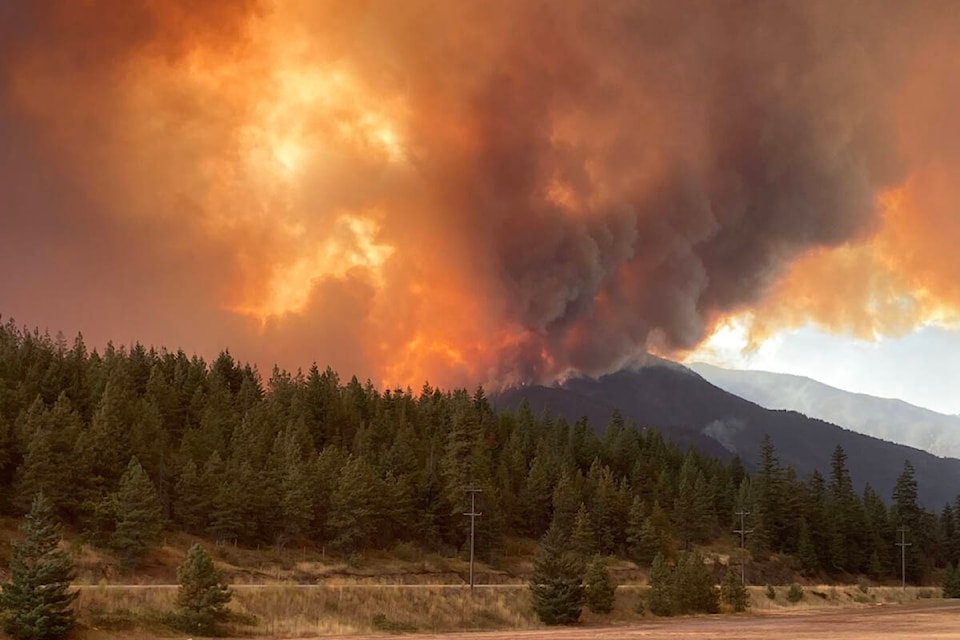Municipalities and First Nations can now apply for money through the disaster financial assistance program after wildfires have burnt an “astronomical” amount of land and hundreds of structures.
Emergency Management Minister Bowinn Ma made the announcement during her latest update on the wildfire and drought situation Wednesday (Sept. 6). Forests Minister Bruce Ralston as well as senior emergency staff representing various agencies joined her.
Ma could not cite a specific number of available funds available through the program, which covers losses by disasters, which are not insurable.
“Wildfire insurance is widely available across the province except the public sector, so most of the disaster financial assistance available here will go to support First Nations, local governments, regional districts and the rebuilding of public infrastructure,” she said. “We cover up to 95 per cent of those costs and we work closely with those communities on their recovery plans.”
She also addressed questions about financial support for individuals who lost homes but lack wildfire insurance. They should contact their insurance companies, she said.
“That being said, we are aware they will likely require ongoing support in terms of housing and their immediate needs.”
Emergency support teams have currently deployed across the province, she said.
Ma’s announcement about financial support confirms once again that the 2023 wildfire season will go down as historic, with efforts now shifting — at least in part — to assessing damages in the face of cooler temperatures and rising humidity as the season change.
“Assessments are still underway to determine the extent of the damage caused to structures, both public and private in communities. Homes have been lost, businesses have been impacted and livelihoods have been put in jeopardy.”
She added the full extent of damage is not yet known, but it doesn’t change the pain or hardship people are going through.
B.C. hit a grim milestone over the weekend: Wildfires in the province have now burned more than two million hectares of land as of Sunday afternoon. By Wednesday, it was up to more than 2.2 million hectares burned from 2,087 wildfires since April 1.
“These numbers are astronomical,” said Ma. “It has been a relentless fire season, which has been compounded by severe drought and the impacts of climate change.”
READ MORE: B.C.’s fire damage tops 2 million hectares
Roughly three-quarters of the fire damage — around 1.7 million hectares — has been in the Prince George Fire Centre’s area, in northeastern British Columbia. However, other regions of the province have also sustained significant fire damage.
Previously, British Columbia’s worst fire season on record was in 2018 when 2,118 fires destroyed 1.34 million hectares.
But if the focus has been shifting toward assessing and recovering from wildfire damage, B.C. remains in a state of emergency, which was extended on Aug. 31 for another two weeks.
Officials around the cabinet table and on the ground also continue to keep their eyes on northern parts of the province, while urging British Columbians to remain prepared.
Ma said wildfires in northern British Columbia in the Vanderhoof and Fort St. James regions displayed aggressive behaviours, which may resume.
“With the Labour Day weekend behind us and fall fast approaching, some might assume that the wildfire season has ended,” Ralston said. “It has not. The fire situation across the province is still very active and every precaution should be taken by all.”
Both Ralston and Ma also touched on this year’s drought situation, which is unlike anything the province has ever faced.
“In my opinion (it) truly is a sleeping giant of a natural disaster that we are challenged with right now,” Ma said. “The impacts will be very real, which is why we have been communicating to the public since April the need to voluntarily reduce water use and conserve water.”
READ MORE: B.C. extends state of emergency by 2 weeks to due wildfires, drought
The majority of the province remains at level 4 or 5 drought conditions, the two highest drought levels.
Ralston also addressed ranchers and farmers concerned about shortages of feed and water. “I want to assure them that we hear their concerns,” he said, pointing to ongoing meetings since June 2023 involving local, provincial and federal representatives. Staff have also been working with First Nations, water licence holders and other stakeholders.
“We are working hard to make sure people have the water they need.”
He also pointed to various support programs designed to help farmers, including plans to purchase more feed.
The update comes as a group of displaced Shuswap residents are set to tour their fire-ravaged community Wednesday as well. It’s estimated the out of control Bush Creek East wildfire – which is now about 43,084 hectares but hasn’t seen growth since Aug. 31 – damaged or destroyed as many as 200 homes.
READ MORE: Shuswap residents get first look at area wildfire ‘changed dramatically’
– With files from John Arendt
